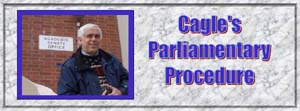
Link to Cagle's Questions page and index.
Link to Cagle's Parliamentary Procedure page.
In parliamentary procedure, there is an assumption that when a group passes a motion, it means it.
A motion to reconsider is appropriate at a meeting to correct an error that becomes known during the meeting. It is subject to a few rules, such as only being permissible the same day (or next calendar day), to move the motion one must be on the prevailing side of a vote, etc.
At subsequent meetings, a group can change previous actions. To protect the rights of members who may not wish to attend a meeting due to the agenda items, if someone moves to change a previous action (generally called a motion to rescind) without giving prior notice (as on the agenda call to the meeting or by a verbal statement at the prior meeting), then it would take 2/3 to rescind (or amend) the previous actions.
With prior notice, it is only a majority.
To figure a 2/3 vote, the simplest procedure is to double the number of negative votes cast. The affirmative votes need only have that number or more to pass.
If the notice of the May meeting (i.e., agenda) indicated that this item would be on the agenda and that a motion would be made to change the December motion, that is proper notice.
The ruling by the chair was: Since all original parties were not present at the May meeting nor did the absent members send a proxy, that to RECONSIDER the motion would be by 2/3 vote and not majority.
A couple of points here: (1) The only thing necessary at the May meeting is a quorum, which would allow the members present to do whatever they wanted legally. (2) Unless provided for explicitly in bylaws, under Robert's Rules of Order Newly Revised, proxies are not permitted. (3) Who is at the May meeting is irrelevant so long as there is a quorum. Motions to rescind or to amend something previously adopted have nothing to do with how people voted on the earlier motion. (4) The motion to Reconsider can only be made at the meeting (i.e., December) the motion was passed [or the next calendar day], so it was not in order at the May meeting. (5) The December motion could be changed with a motion to Rescind or a motion to Amend Something Previously Adopted (which have the same rules). If previous notice had been given (see above), then a majority is all that is needed to rescind or amend the previously adopted motion. Without previous notice, then a 2/3 vote is needed.
I am interested in this ruling, as I also chair another committee and wanted to verify this parliamentary procedure.
Return to Cagle's Questions page and index.
Link to Cagle's Parliamentary Procedure page.